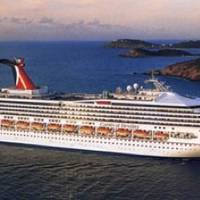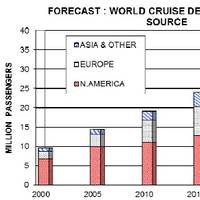Container Shipping: China-US Box Rates Eclipse $20,000 Mark, a Record

Container shipping rates from China to the United States have scaled fresh highs above $20,000 per 40-foot box as rising retailer orders ahead of the peak U.S. shopping season add strain to global supply chains.The acceleration in Delta-variant COVID-19 outbreaks in several counties has slowed global container turnaround rates.Typhoons off China's busy southern coast in late July and this week have also contributed to the crisis gripping the world's most important method for moving…
Cargo Growth Forecast at Canada's West Coast Ports
Ocean Shipping Consultants' 2016 container traffic report for the west coast of Canada forecasted that container demand through the Port of Vancouver and Port of Prince Rupert would be 6.62 million twenty-foot equivalent unit containers (TEUs) by 2030 (base case), with 5.93 million TEUs and 7.53 million TEUs as the low case and high case respectively. The forecast shows continued growth in container trade through the west coast of Canada at a compound annual growth rate of about 4 percent, and reinforces the need for planned increases of capacity to ship goods in containers through the existing Deltaport and Centerm terminals in Vancouver and the Fairview Terminal in Prince Rupert. The report also confirms that the proposed Roberts Bank Terminal 2 Project will be needed by the mid-2020s.
Consultants Predict Dynamic Cruise Sector Growth

The global cruise sector is forecast to exhibit dynamic growth over the next decade, according to Ocean Shipping Consultants’ (OSC) latest report: 'World Cruise Ports and Shipping'. OSC expects annual passenger demand to rise from around 20.9 million in 2012 to approximately 24m passengers by 2015, 29.7m by 2020 and 36.4m by 2025. This represents an overall forward expansion of 74%. North America will still dominate the world cruise industry in terms of sourced passengers and cruise operators, but Europe and Asia Pacific are expected to grow strongly.
Report Outlines Strong Cruise Industry Prospects

According to the latest publication from U.K.-based market consultants Ocean Shipping Consultants – “World Cruise Ports and Shipping” – the global cruise sector is forecast to exhibit dynamic growth in the period up to 2025, taking annual passenger demand up from around 20.9 million in 2012 to approximately 24m passengers by 2015, 29.7m by 2020 and 36.4m by 2025. This represents an overall forward expansion of 74%. North America will still dominate the world cruise industry in terms of sourced passengers and cruise operators, but Europe and Asia Pacific are expected to grow strongly.
Competitiveness of Polish Container Ports
Polish consumers could save money and the Polish Government earn billions of zloty in extra import duties if the bulk of container traffic from the Far East was directed through Polish ports rather than through German and Benelux ports, according to Boris Wenzel, CEO of the Deepwater Container Terminal in Gdansk. A switch to Gdansk would also create thousands of new jobs in the Tri-city and reduce the high Co2 emissions associated with trucking and railing containers to Poland from ports like Rotterdam and Hamburg, believes Mr. Wenzel. “Over the past decade Hamburg and Rotterdam have taken advantage of Poland’s rapid economic growth to develop into this country’s largest container gateways“ says Mr. Wenzel.
Feature: Will there be a Feeder Frenzy?
A study commissioned by Lloyd's Register and conducted by Ocean Shipping Consultants has determined that major investment will be required in feeder and shortsea containerships through to the end of the decade, in support of surging development in the trade and in the size of the deepsea mainline vessels. Over 25 percent of today's worldwide boxship fleet, and nearly 60 percent of the present orderbook, is in the post-Panamax category, and it appears ever more likely that the industry will see the first 12,500-TEU vessels before 2011. "The demand for big ships will clearly lead to higher demand for transhipment," said David Tozer, Lloyd's Register's Business Manager, Container Ships.
LNG Fleet Needs to Triple by 2020
World LNG demand is forecast to rise from 158 billion cubic meter (bcm) to 269 bcm by 2010 and to 428.5 bcm by 2020. This growth represents an average annual trade growth of 7.6% over the near-term, with a slowing to 5.4% through to 2015 and 4.9% up to 2020. Such trade growth will necessitate an increased vessel building program. Currently there are 59 vessels on order, but to match the expected development of trade volumes an additional 33 vessels are required through to 2010, 76 vessels in the period 2010-15 and 83 vessels up to 2020. These are some of the findings of the new report on the LNG sector, published by Ocean Shipping Consultants Ltd.
Behemoth in the Offing?
Attuned to the liner shipping industry's unerring drive for economies of scale, classification society Lloyd's Register (LR) has developed a conceptual design of container vessel incorporating a 12,500-TEU capacity. Although some 55-60 percent greater in slot capacity than the biggest cellular vessels ordered to date, the envisaged Ultra Large Container Ship (ULCS) would be able to transit the Suez Canal and access key ports. LR considers that there are no insurmountable technical challenges to vessels of 12,500 TEU, and believes that it is only a matter of time before such tonnage makes its appearance in deep sea trade. The next five to 10 years could see the uptake of the envisaged new breed of behemoths by the container shipping industry.
Ocean Shipping Consultants Release Container Ports and Terminals Report
and summarizes the major strategic issues facing the market. latest demand projections. The study details forecasted demand growth by region; the impact of new industry structures; productivity and regional trends; definition of changes in the terminal market; the impact of emerging rules and regulations; approaches to the container terminal tendering process; ways of reducing environmental impact and easing congestion. shipping lines and all those engaged in this market sector.
OSC Releases Study on Container Port Strategy
Ocean Shipping Consultants released a new in-depth study that looks at the market for container ports and terminals and summarizes the strategic issues facing the market. Container Port Strategy summarizes the issues driving the market and details OSC's latest demand projections. The study details: forecast demand growth by region; the impact of new industry structures; productivity and regional trends; definition of changes in the terminal market; the impact of emerging rules and regulations; approaches to the container terminal tendering process; and ways of reducing environmental impact and easing congestion. shipping lines and all those engaged in this market sector. A brochure detailing the study can be downloaded from the OSC website.
LPG Fleet Rates Rise
The world LPG carrier fleet is forecast to expand from 14.5 million cu. beginning of 2005 to 24.6 million cu. m. by 2015. World seaborne LPG trade (including ammonia and petchems) is forecast to increase from 73 mt to 132 mt over the same period. These are some of the findings in the new detailed report – entitled ‘LPG Carriers: Market Prospects to 2015’ – which analyses the current and historical developments within the LPG carrier sector and examines the prospects for trade and fleet development under alternative scenarios, presenting detailed forecasts for trade volumes, fleet requirements and freight rates through to 2015. • The world LPG fleet was estimated at 14.5m cu.
Surplus Of Chemical Tankers To Reduce Earnings
The world's fleet of chemical tankers has risen by 25 percent over the last four years, leading to a tonnage glut and the specter of reduced revenues for shipowners, an industry report said. The report, by Ocean Shipping Consultants, said shipowners will be forced to reduce costs and increase efficiency to counter the estimated growth in the fleet to 23.5 million dwt by the end of this year. The deliveries of new tankers over the last four years has come at a bad time for the industry which is struggling to recover from the Asian economic crisis of the late 1990s which reduced trade. Chemical tankers are also facing the added challenge of adapting to changing patterns of the petrochemical trade brought about by a rise in Asian petrochemical capacity…
Surplus Of Chemical Tankers To Reduce Earnings
The world's fleet of chemical tankers has risen by 25 percent over the last four years, leading to a tonnage glut and the specter of reduced revenues for shipowners, an industry report said. The report, by Ocean Shipping Consultants, said shipowners will be forced to reduce costs and increase efficiency to counter the estimated growth in the fleet to 23.5 million dwt by the end of this year. The deliveries of new tankers over the last four years has come at a bad time for the industry which is struggling to recover from the Asian economic crisis of the late 1990s which reduced trade. Chemical tankers are also facing the added challenge of adapting to changing patterns of the petrochemical trade brought about by a rise in Asian petrochemical capacity…
LR: 1,900 New Containerships by 2012
Hand-in-hand with the accelerated development in the size of long-haul container vessels must come changes in the structure, design and deployment of the feedership fleet. According to David Tozer, Lloyd's Register's Business Manager for Container Ships, some 1,300 new vessels will be required to accommodate anticipated cargo growth in the feeder trades up to 2012. The calculation is based on projections of a doubling in trade volume in feeder and intra-regional operations during the period 2002-2012. Moreover, around 600 newbuilds will also be needed to replace existing tonnage over the same timeframe, suggesting a total demand in the order of 1,900 ships.







